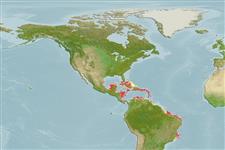Preferred temperature (Ref.
123201): 26.5 - 28.2, mean 27.5 °C (based on 632 cells).
Phylogenetic diversity index (Ref.
82804): PD
50 = 0.5005 [Uniqueness, from 0.5 = low to 2.0 = high].
Bayesian length-weight: a=0.00089 (0.00039 - 0.00204), b=3.00 (2.80 - 3.20), in cm total length, based on LWR estimates for this (Sub)family-body shape (Ref.
93245).
Niveau trophique (Ref.
69278): 3.6 ±0.4 se; based on diet studies.
Résilience (Ref.
120179): Milieu, temps minimum de doublement de population : 1,4 à 4,4 années (Preliminary K or Fecundity.).
Fishing Vulnerability (Ref.
59153): High to very high vulnerability (66 of 100).
Nutrients (Ref.
124155): Calcium = 32.1 [17.1, 53.7] mg/100g; Iron = 0.471 [0.278, 0.983] mg/100g; Protein = 18.9 [16.6, 21.5] %; Omega3 = 0.0893 [, ] g/100g; Selenium = 38.2 [21.4, 78.0] μg/100g; VitaminA = 45 [13, 136] μg/100g; Zinc = 0.907 [0.646, 1.275] mg/100g (wet weight);
